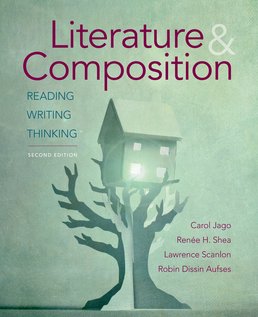- High School Community
- :
- Language Arts Community
- :
- ELA Blog
- :
- ELA Blog - Page 2
ELA Blog - Page 2
Options
- Mark all as New
- Mark all as Read
- Float this item to the top
- Subscribe
- Bookmark
- Subscribe to RSS Feed
ELA Blog - Page 2
Showing articles with label AP® Language.
Show all articles
Community Manager
07-02-2020
11:15 AM
1. Meet the Authors
7. Argument chapter revision
13. Conversations
19.Technology
2. Overview & History
8. Thematic chapter organization
14. Visual arts program
20. Conclusion
3. Course Overview
9. New readings
15. Teacher support program
21. Good luck on the exam!
4. Why Revise
10. Essays & Central texts changes
16. Teacher's Edition
5. Introductory, skill building chapters and the AP exam
11. Central texts
17. Text Talks
6. Close reading chapter revision
12. Classic essays
18. Digital test bank
The Language of Composition
... View more
The Language of Composition


Renee Shea; Lawrence Scanlon; Robin Dissin Aufses; Megan Harowitz Pankiewicz
The Language of Composition
Language Arts
Labels
-
AP® Language
-
Videos
0
0
1,196
Macmillan Employee
06-22-2020
02:36 PM
Looking for exam prep resources? We've included the CED at a glance, graphic organizer, and rubric below for AP® Lang. You can also check out our webinar dedicated to this topic! In this webinar, author Kate Cordes will discuss how to make the most of the final month leading up to the AP® Literature and Language exams now that teaching and learning must happen from a distance. She will offer suggestions for how to utilize BFW’s online resources, AP® Classroom’s progress checks and questions banks, or your own units and assessments to determine student strengths and weaknesses. The webinar will also offer helpful text suggestions that target the skills most often emphasized in the new CEDs. Finally, we will share ways to support your students as they prepare for the revised online exams.
... View more
Labels
-
AP® Language
-
Virtual Learning
0
0
2,085
Macmillan Employee
06-22-2020
02:21 PM
Bedford, Freeman & Worth High School Publishers (BFW) is widely considered “the AP® publisher,” and we take that role very seriously. Because of this, we feel it necessary to lay all cards on the table so you know exactly what is being offered for your teachers now – and in the future. View the attached flyer or visit our AP® Updates site to learn more.
The Language of Composition
... View more
The Language of Composition


Renee Shea; Lawrence Scanlon; Robin Dissin Aufses; Megan Harowitz Pankiewicz
The Language of Composition
Language Arts
Labels
-
AP® Language
-
AP® Literature
0
0
1,395
Macmillan Employee
06-22-2020
02:06 PM
In the attached slide deck, Robin Aufses discusses the power of visual images and the questions to ask your students when analyzing them.
... View more
Labels
-
AP® Language
-
AP® Literature
-
Pre-AP® 9th and 10th grade
1
0
1,401
Macmillan Employee
06-22-2020
02:01 PM
Documentaries are powerful texts! In the attached slide deck, Megan Pankiewicz covers how to use documentaries to inform, analyze, and as a source in your AP® Language classroom.
... View more
Labels
-
AP® Language
0
0
4,869
Macmillan Employee
06-22-2020
01:46 PM
In the attached guide, Kate Cordes discusses the benefits of vertical teaming and an intentionally scaffolded approach using BFW Textbooks with 9th-12th Graders.
Advanced Language & Literature
Literature & Composition
The Language of Composition
Foundations of Language and Literature
... View more
Advanced Language & Literature


Renee H. Shea; John Golden; Lance Balla
Advanced Language & Literature
Language Arts
Literature & Composition


Carol Jago; Renee H. Shea; Lawrence Scanlon; Robin Dissin Aufses
Literature & Composition
Language Arts
The Language of Composition


Renee Shea; Lawrence Scanlon; Robin Dissin Aufses; Megan Harowitz Pankiewicz
The Language of Composition
Language Arts
Foundations of Language and Literature


Renee H. Shea; John Golden; Tracy Scholz
Foundations of Language and Literature
Language Arts
Labels
-
AP® Language
-
AP® Literature
-
Pre-AP® 9th and 10th grade
0
0
1,765
Macmillan Employee
06-22-2020
01:28 PM
Bedford, Freeman & Worth was founded on the principle that a publisher is only as good as the books it publishes and the people behind them. We know that what happens in the classroom matters and that a good class, teacher, and textbook have the power to make a difference in students’ lives. That’s why we were the first publisher to create an AP® English Language textbook tailored to meet the needs of high school students. View the attached infographic to see how it works!
The Language of Composition
... View more
The Language of Composition


Renee Shea; Lawrence Scanlon; Robin Dissin Aufses; Megan Harowitz Pankiewicz
The Language of Composition
Language Arts
Labels
-
AP® Language
0
0
1,393
Macmillan Employee
06-22-2020
01:17 PM
We can't wait to connect with you at an APSI®! Watch this video to see how we've got you covered this summer, and then click below to access more resources.
I'm attending an APSI® I'm not attending, but still want resources!
... View more
Labels
-
AP® Language
-
Videos
0
0
917
Macmillan Employee
06-17-2020
02:31 PM
View the attached document for the Unit-Based Pacing Guide for the 2019 AP® Course Framework Shea, The Language of Composition, 1st Edition. Have any questions? Let us know! We're here to help.
The Language of Composition
... View more
The Language of Composition


Renee Shea; Lawrence Scanlon; Robin Dissin Aufses; Megan Harowitz Pankiewicz
The Language of Composition
Language Arts
Labels
-
AP® Language
0
0
1,885
Macmillan Employee
06-17-2020
02:25 PM
Pre-AP to AP English: Using the BFW Pre-AP to AP ELA Series to Meet the New CB Requirements
View the attached document to see our alignment examples across the ELA series.
... View more
Labels
-
AP® Language
-
AP® Literature
-
Pre-AP® 9th and 10th grade
0
0
1,235
Macmillan Employee
06-16-2020
06:17 AM
On-Demand
In the new rubrics, the phrase "line of reasoning" appears numerous times for each essay type. But what does it mean? And how do we prepare our students to demonstrate their understanding of the concept? Join the authors of The Language of Composition, 3rd Ed. in a discussion on how the concept of "line of reasoning" functions in the course and how it will be assessed on the rubrics.
The Language of Composition
... View more
The Language of Composition


Renee Shea; Lawrence Scanlon; Robin Dissin Aufses; Megan Harowitz Pankiewicz
The Language of Composition
Language Arts
Labels
-
AP® Language
-
Webinars
0
0
1,037
Macmillan Employee
06-16-2020
06:15 AM
On-Demand
Authors Renée Shea, Larry Scanlon, Robin Aufses, and Megan Pankiewicz discuss the 2019 AP® Language exam results and how you can prepare your students for the 2020 exam using The Language of Composition.
The Language of Composition
... View more
The Language of Composition


Renee Shea; Lawrence Scanlon; Robin Dissin Aufses; Megan Harowitz Pankiewicz
The Language of Composition
Language Arts
Labels
-
AP® Language
-
Webinars
0
0
990
Macmillan Employee
06-16-2020
06:10 AM
On-Demand
In this webinar, authors Kate Cordes and Megan Pankiewicz will discuss ways to scaffold your Pre-AP® and AP® English courses to truly align as a vertical team. They will discuss the ways in which the books and programs work with one another to build key skills and understanding before approaching more difficult AP® topics.
Foundations of Language and Literature
Advanced Language & Literature
... View more
Foundations of Language and Literature


Renee H. Shea; John Golden; Tracy Scholz
Foundations of Language and Literature
Language Arts
Advanced Language & Literature


Renee H. Shea; John Golden; Lance Balla
Advanced Language & Literature
Language Arts
Labels
-
AP® Language
-
AP® Literature
-
Pre-AP® 9th and 10th grade
-
Webinars
0
0
1,277
Macmillan Employee
06-16-2020
06:06 AM
On-Demand
BFW invites you to our AP® updates webinar with authors Reneé Shea, Larry Scanlon, Robin Aufses, and Megan Pankiewicz. In this webinar, our authors and AP® experts will discuss the goals of the courses, new changes, and what they mean for you.
... View more
Labels
-
AP® Language
-
AP® Literature
-
Webinars
0
0
1,047
Community Manager
04-09-2020
01:55 PM
ON-DEMAND
Suddenly, we are living in a whole new world. In this webinar, author Kate Cordes will discuss how to make the most of the final month leading up to the AP ®️ Literature and Language exams now that teaching and learning must happen from a distance. She will offer suggestions for how to utilize BFW’s online resources, AP®️ Classroom’s progress checks and questions banks, or your own units and assessments to determine student strengths and weaknesses. The webinar will also offer helpful text suggestions that target the skills most often emphasized in the new CEDs. Finally, we will share ways to support your students as they prepare for the revised online exams.
About Kate Cordes
Kate Cordes is a National Board Certified English Teacher who currently teaches 10th grade English, 12th grade English, and AP®️ English Literature at Skyview High School. She received her undergraduate degree in English, Psychology, and Medieval Studies from St. Olaf College and spent a year at Oxford University studying Medieval and 20th-century British Literature. With a master's degree in education from Montana State University-Billings, she focuses her teaching efforts on writing instruction, technology integration, and becoming the best teacher and leader possible.
The Language of Composition
Literature & Composition
... View more
The Language of Composition


Renee Shea; Lawrence Scanlon; Robin Dissin Aufses; Megan Harowitz Pankiewicz
The Language of Composition
Language Arts
Literature & Composition


Carol Jago; Renee H. Shea; Lawrence Scanlon; Robin Dissin Aufses
Literature & Composition
Language Arts
Labels
-
AP® Language
-
AP® Literature
-
Virtual Learning
-
Webinars
0
0
3,171
Topics
-
AP® Language
38 -
AP® Literature
32 -
Pre-AP® 9th and 10th grade
25 -
Videos
11 -
Virtual Learning
3 -
Webinars
15
Popular Posts
BFW's Legacy of Innovation in High School English Continues
PhoenixHarvey
Macmillan Employee
2
0
FIVE Practical Tips for Using BOTH texts in the Ideas Series
b-digeronimo
Macmillan Employee
1
0
AP® Language Living Table of Contents
tiffani-tang
Community Manager
1
0









